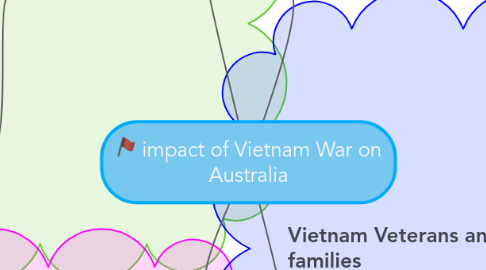
1. Australian Culture
1.1. Indochinese Refugees
1.1.1. Multiculturalism
1.1.1.1. Immigration Restriction Act, 1901, or "White Australia" policy, was ended in 1973
1.1.1.1.1. Official policy of Whitlam (Labor) government in 1973 and carried on by Fraser (Liberal) government afterwards
1.1.1.1.2. For the first time in the 20th century, Australian society was taking in large numbers of new arrivals who weren’t European in origin.
1.1.1.2. Many Australians feared that Australian culture would disappear, stimulated by traditional fears of the 'yellow peril' and concern about high unemployment.
1.1.1.2.1. It became something to embrace rather than fear
1.1.1.2.2. Each new wave of migrants—whether from Asia, Africa or the Middle East—has been thought of as too ‘different’ to fit in.
1.1.2. over 90,000 Indo-Chinese refugees came to Australia in the 10 years after the end of the war.
1.1.2.1. By 1978 Australia was involved in the Orderly Departure Program form Vietnam
1.2. 1967 Referendum
1.2.1. ATSI people were to be counted in the National Census, making them citizens of Australia for the first time
1.2.1.1. New policy of integration (still bad) instead of assimilation.
1.2.2. ATSI people could no longer be restricted in their movements or kept on 'reservations' in their State.
1.3. Changing role of women
1.3.1. Greater voice to women in Australian society initially through protest activism
1.3.1.1. Women play greater role in politics, and received a higher level of education and wages (still nowhere near equal to men)
1.3.1.2. Challenge to the 'housewife/mother' ideal of 1950s and early 60s.
1.3.1.2.1. For example, right up until 1966, a married woman had to give up her career because she had a new job--being a wife and mother. Women were also not integrated into the military until the late seventies.
2. Protest groups
2.1. Anti-war protests had be going on since 1962
2.1.1. Selective conscription and television reports increased levels of protests
2.1.1.1. ALP on the side of protesters
2.1.1.2. The government's plan to put soldiers into Vietnam was called "blood for dollars" or "diggers for dollars" by Trade Unions
2.1.1.2.1. by supporting USA and risking lives of Australians we would have a more stable economy and a stronger alliance
2.1.1.2.2. Trade unions used work stoppages as anti-war protests
2.1.1.3. Churches were divided
2.1.1.3.1. Division increased between the Catholic bishops who supported the war against communism and their local priests and parishioners
2.1.1.3.2. The Methodist and Uniting churches, as well as Jews, Quakers and some Buddhists were anti-war from the beginning
2.1.1.3.3. Anglican bishops asked government not to increase Australia's involvement by sending troops
2.1.1.4. University groups were strongly opposed
2.1.1.4.1. in the early years university students were divided
3. Australia's relations with Asia
3.1. Recognition Australia was 'part of Asia'
3.1.1. Greater diplomatic and trade relations with South East Asia
3.1.1.1. Opening up of greater diplomatic relations between Australia and China
3.1.1.1.1. 1971 Whitlam became the first Australian political leader to visit Communist China. He returned in 1973 as PM.
3.1.1.2. New trade links with Asia
3.1.1.2.1. 1974 Australia became a member of Association of Southeast Asian Nations (ASEAN) which promotes economic growth, social progress and cultural development
3.1.2. Abandonment of Immigration Restriction Act,1901 or 'White Australia' policy
3.1.2.1. Arrival of Asian refugees
3.1.2.1.1. Need to escape communist rule due to association with allies and South Vietnamese government
3.1.2.1.2. Many people, including orphans, were evacuated by Australian and US governments and agencies
3.1.2.2. Issuing of tourist visas to visit Australia
4. Vietnam Veterans and their families
4.1. Physical
4.1.1. Wounded
4.1.1.1. multiple disabilities making it harder/impossible to return to civilian life as no support for returning to work/retraining
4.1.2. Poisoned by insecticides and defoliants
4.1.2.1. 1985 Royal Commission determined that there was no exposure to Agent Orange
4.1.2.1.1. No compensation and no recognition of health issues
4.1.2.2. Cancer, Birth defects, Miscarriages, Brain dysfunctions and other physical disabilities due to exposure to Agent Orange and other chemicals such as DDT
4.1.2.2.1. long term psychological issues dealing with these issues
4.2. Psychological
4.2.1. Post Traumatic Stress Disorder (PTSD)
4.2.1.1. Substance abuse
4.2.1.1.1. alcohol
4.2.1.1.2. drugs
4.2.1.2. Effects misunderstood
4.2.1.2.1. Suicide
4.2.1.3. Compensation but no long term mental health planning
4.2.1.4. Violence/domestic violence
4.2.1.4.1. wives and family left to deal with effects of PTSD
4.2.2. "Lost" time
4.2.2.1. 'Lost' 2 years of their lives
4.2.2.1.1. difficulties readjusting to civilian lives
4.2.3. Lack of understanding
4.2.3.1. civilians were not aware of what the returned servicemen had gone through
4.2.3.1.1. felt 'shunned' by society
4.2.4. Lack of recognition
4.2.4.1. No welcome home parades like those from previous wars
4.2.4.1.1. felt'blamed' for the war - "baby killers"
